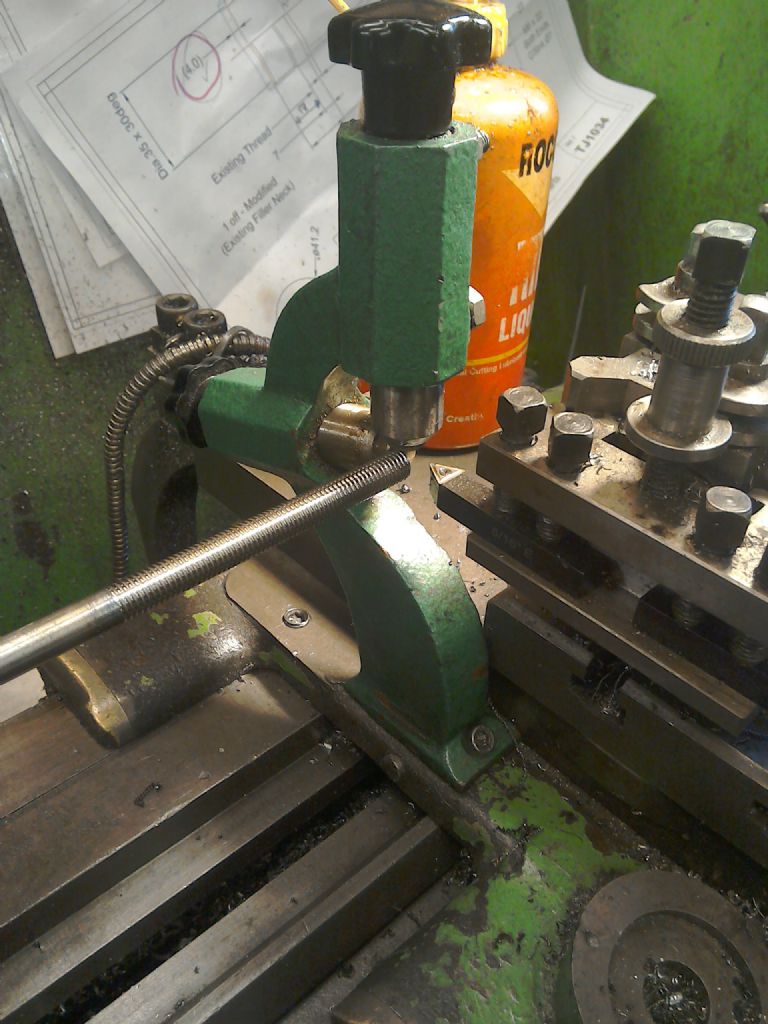Not a good evening playing with my still new to me Colchester Bantam Mk1, and as I sit down to write this i realise almost all of it was my own fault (long time since I used a lathe).
I set it up to cut my first thread, a 9/16 UNC external thread in a bit of EN16 steel using a cheap Chinese indexable carbide tool from Banggood (which actually seems not too bad).
First pass went fine, until i overshot slightly when the inertia kept the chuck turning a bit longer than i anticipated, even at a lowly 35rpm. It didn't occur to me to use the brake!
Reading the instructions, the Bantam should be reversed as it doesn't have a thread dial (and I was cutting imperial on a metric machine anyway). So, i engaged reverse direction and set out to cut on the reverse pass (spot the obvious mistake). To my horror it didn't line up properly with the forward pass, and then to add insult to injury chipped the top off the carbide tip.
Oh well, turn the tip round and use another point. Look at lateral movement in feed screw, of which there seemed to be quite a lot, adjust out end float and have another go, forward. It seemed to line up with the first forward pass OK. I didn't even overrun this time.
Now for cutting on the reverse pass again. It didn't line up, again. Although this time was slightly better than first go. Then i brole the tip off again. Doh! I was now getting frustrated (and had still not realised the obvious mistake).
Lots of looking and measuring the lateral play in the carriage with the feed nut engaged, about 0.1mm. Starting to conclude the feednut must be worn and in need of replacement, which sounded expensive.
At this point things went from bad to worse. Traces of smoke started to emanate from the back of the lathe, the motor to be precise. Ever since I bought it it would occasionally buzz loudly when the forward/reverse lever was in the off position. On this occasion it had been doing that for a minute or so whilst I was distracted looking at the play in the feednut (i'd usually turn it off at the wall when it did it). I suspect something is wrong with the original electrics and it was managing to somehow power one coil and not the other, or one in forward and one in reverse. Anyway, I quickly turned off the power and the faint trace of smoke quickly stopped. Not what you want when you're already frustrated.
Time to give up for the evening and consult the forum as to the state of the feednut. Then, as I started to type it dawns on me. The reason I was breaking the tips and the forward and reverse passes weren't lining up properly was because I'm not meant to be cutting on the reverse pass, only on the forward. Under normal circumstances I'm pretty switched on, but this evening I'd clearly left my common sense in the house. The work was turning backward and the compression force on the underside of the tip was causing to to break. The feednut was loaded against the opposite face of the screw on the return and the backlash mean it was never going to line up. Even it it was a new screw and nut it probably wouldn't have worked.
As usual, the problem was the operator not the machine (except for the now poorly motor).
Hopefully the smoke was just burning oil and not insulation/enamel or the 3 phase and VFD conversion might be upon me earlier than I was planning. I'll have a second attempt tomorrow after checking out th eNVR and reversing electrics. I'll use a HSS tool this time, as carbide at 35 rpm probably wasn't the best choice anyway, even when cutting in the right direction.
Edited By Mark Davison 1 on 11/01/2019 23:07:22
Edited By Mark Davison 1 on 11/01/2019 23:08:05
Anonymous.





